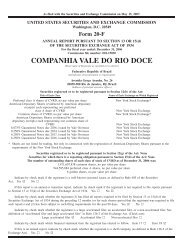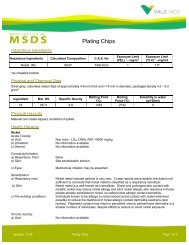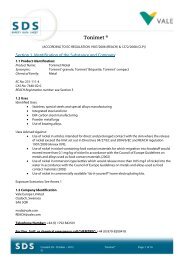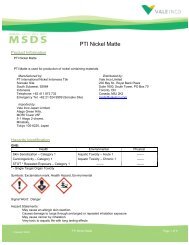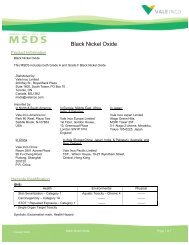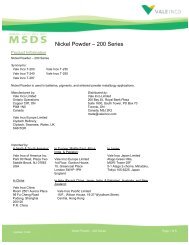Create successful ePaper yourself
Turn your PDF publications into a flip-book with our unique Google optimized e-Paper software.
Stability and Reactivity<br />
pH (40g/100ml) 4-6<br />
Boiling point/ boiling range N/A<br />
Freezing point / freezing range N/A<br />
Flash Point<br />
N/A<br />
Evaporation rate<br />
N/A<br />
Flammability<br />
N/A<br />
Explosive properties<br />
N/A<br />
Vapour pressure<br />
N/A<br />
Vapour density<br />
N/A<br />
Bulk density 0.9 g/cm 3<br />
Solubility cold water<br />
>250 g/l<br />
Solubility hot water<br />
>550 g/l<br />
Partition coefficient<br />
N/A<br />
Auto-ignition temperature N/A<br />
De<strong>com</strong>position temperature De<strong>com</strong>poses on heating Anhydrous salt<br />
sublimes at 450°C<br />
Oxidizing properties<br />
Not oxidizing<br />
Viscosity<br />
N/A<br />
Particle size<br />
N/A<br />
Conditions to be avoided:<br />
Substances to be avoided:<br />
Hazardous de<strong>com</strong>position<br />
products:<br />
Unreactive. Can liquefy at temperatures >~40 ° C<br />
None.<br />
At high temperatures toxic chlorine containing gases may be evolved.<br />
Toxicological Information 3<br />
<strong>Nickel</strong> <strong>Chloride</strong><br />
Inhalation:<br />
The International Agency for Research on Cancer (IARC) in 1990 and the U.S. Tenth Report on<br />
Carcinogens in 2002 concluded that here was sufficient evidence that nickel <strong>com</strong>pounds are<br />
carcinogenic to humans. In 1999 Toxicology Excellence for Risk Assessment (TERA) found<br />
that carcinogenic risk from soluble nickel <strong>com</strong>pounds via inhalation could not be determined<br />
because the existing evidence was <strong>com</strong>posed of conflicting data.<br />
Epidemiological studies of Norwegian nickel refinery workers showed than an increased risk of<br />
respiratory cancer was present in electrolysis plant workers. These workers had mixed exposure<br />
to aerosols of nickel sulfate and nickel chloride and to insoluble forms of nickel. Electrolysis plant<br />
workers in an Ontario refinery similarly exposed to nickel sulfate and nickel chloride aerosols, but<br />
not the dust from matte roasting operations, did not show any increased incidence of respiratory<br />
cancer.<br />
Updated: 07/09<br />
In<strong>com</strong>ond <strong>Nickel</strong> <strong>Chloride</strong> Page 6 of 8



